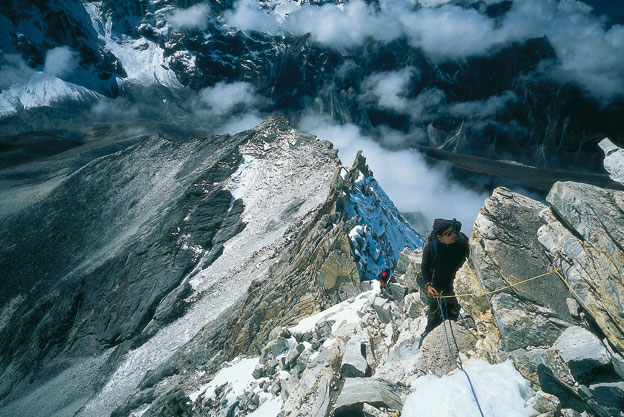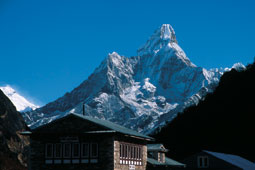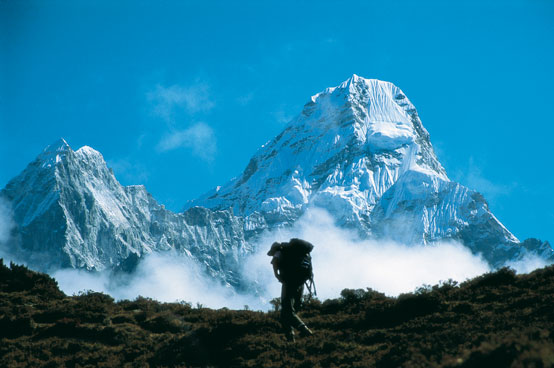


Ama Dablam
The Matterhorn of the Himalayas
The aesthetics of a summit is already part of the dream which is being realised in the mind of alpinists. It remains for the body to be satisfied by an appropriate technical appeal. The pyramid shape of this mountain was something that always attracted the infamous and late Sir Edmund Hillary who, after his first ascent of the roof of the world, declared it to be unscalable before then coveting it.
Ama Dablam Texts and photos Stéphane Schaffter
Ama Dablam could be translated by ‘mother’s jewellery box’. âAmaâ for its long crests symbolising the arms of a protective mother, âDablamâ for a box containing the photos and jewels of a woman from Nepal; the two signifying an almost inaccessible object…
On 13th March 1961, on the initiative of Sir Edmund Hillary, an international rope party nevertheless reached the summit of Ama Dablam. The latter group comprised an English climber Michael Ward, an American, Barry Bishop and two New Zealand climbers, Wally Romanes and Michael Kennedy. This ascent, one of the first to be achieved in Nepal during the winter season, followed the disaster of an attempt at the Makalu, two months earlier, during a scientific expedition.
Today, the normal route passes along the SW arm and still provides a fabulous ascent despite surprising thawing of the glaciers making the passage of the serac more exposed. The perfect geometry of this mountain is revealed from Pangboche, the Zermatt of the Khumbu.
Prelude to the adventure
The capital of Nepal, Kathmandu, provides a very colourful tourist stopover with its profusion of contrasts and its political situation in pursuit of stability. It is also the obligatory passage for various formalities enabling the necessary permits to be obtained in order to practice alpinism above 6,000 metres, a practice which remains a source of revenue for the Sherpa people of rural descent…
Nepal experienced an important period of architectural glory during the reign of the Mallas between 1200 and 1769. It is during that same period that the Newars, an ethnic group specially gifted at art, set themselves apart through the finesse of their wooden sculptures and their paintings.
In the nineteenth century, Jayasthiti, the most popular of the Mallas, officially placed Nepal on the map of Asia as a country of art and prosperity, which still constitutes the very essence of local tourism. In this way, Bhaktapur, Patan, Boudhanath, Swayamblunath and Pashupatinath are all names which enable you to appreciate the Mecca of Nepalese savoir-faire, which constitute unmissable visits during a stopover at the capital.
Getting to know altitude
The immensity of the regions forces alpinists to reduce the distances through internal flights and this time saving has to be carefully managed to ensure the necessary acclimatisation process in view of a stay above our European elevations. For the approach of the Ama Dablam, we use an aerial transfer towards Lukla at the entrance to the Vallées of the Khumbu, which is an hour’s flight from Kathmandu.
At the edge of the national park of Sagarmatha, our approach walk passes along the banks of the Dudh Kosi of which the source begins under the highest glaciers in the world. Namche Bazar, at 3,440 metres, takes 2 days to reach. This Mecca of Sherpa culture is also a theatre for encounters between the locals in search of contacts, Tibetans in search of purchasers of knick-knacks from another world and trekkers in search of spirituality in front of a large cup of tea in the famous lodges! This Chamonix of Nepal is well suited to tourism, almost too much so our ancestors would say…
The walk continues towards the future base camp after a visit to the highest monastery in the valley at Tengboche and the savouring of an excellent Dalbat – a national dish comprised of white rice and a lentil soup – there is even time to go around the splendid chortens to the left, in respect of the Gods. From this ephemeral little village of tents under which each person regains their privacy, a new life begins, that of the true climbers of the Himalayas. This same place marks the end of the trekking zones where you rubs shoulders as much with the locals as hikers from every corner of the globe.
Confrontation with nature
We will set up two camps at altitude: the first at 5,400 m, prior to some rocky obstacles, then a second at around 5,800 m, and the departure zone for an assault of the summit.
After ten days spent equipping the route as well as several others resting in an atmosphere of high pressure, we set off for the final assault. It is two in the morning, when we open our eyes in our small tent hooked onto the mountain. It is a moment which is as tough as it is joyful. For a few long minutes, you have to prepare yourself breakfast on the flame of a carefully balanced gas stove and rope together despite the apprehension or the anxiety of failure. There is a single route towards success: motivation.
The arrival at the summit reveals Everest and concludes this adventure reserved for experienced alpinists, who will remember this unforgettable moment for a long time.
It is also an opportunity to experience a talent for communication and humility in front of the reality of the passages which have been overcome whilst appreciating each of the moments which this context reserves: a sunset to fall asleep with, the sun pointing its nose towards the horizon to warm you up or nibbling a piece of dried meat with a good cup of hot tea and, of course, the comforting thought of the slow-cooked meal at base camp, prepared by an ever attentive cook.
The exceptional satisfaction of a moment at the summit, the anxiety experienced and overcome and the desire to keep striving for success, gives this particular adventure an approach which leads to a sensation of well earned and yet so secret pride within the sphere of alpinists.
Read the rest of the article in the Mountain Report magazine - Where to find ?


